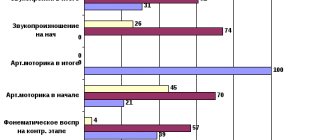With normal speech development, children aged 4-5 years freely use phrasal speech, construct complex sentences, and have more than 3,000 thousand words in their active vocabulary. After 5 years, sound pronunciation is fully formed. These are average standards. If by the age of 2-3 the baby does not speak at all or uses only a few words to communicate with others, grossly violates the grammatical and phonetic rules of the Russian language, then the parents may suspect that he has level 1 OHP. What it is, how to diagnose it and treat it correctly, we will tell you in our article.
Definition
General speech underdevelopment of level 1 is a severe form of speech defect, typical for “speechless” children with a normal level of intelligence and healthy hearing. Such a child exhibits violations of all components of the language system, and non-compliance with language norms is very gross. Children with level 1 ODD violate the rules of phonetics, grammar, vocabulary, and phonetics. Their speech is incoherent, similar to babbling, or it is almost absent. This disease can be detected and diagnosed from 3-4 years of age.
The term “general speech underdevelopment” (GSD) was introduced into science by the Soviet teacher, psychologist, researcher at the Institute of Defectology of the RSFSR, Research Institute of Defectology - Rosa Evgenievna Levina.
She developed the concept of general underdevelopment of speech in the 1960s - this became the main merit of R. E. Levina in science and pedagogy, on the basis of this work she defended her doctoral dissertation.
After a long study of younger preschoolers, Levina came to the conclusion that it is speech underdevelopment that often leads to failure in school. She developed a method of correctional work for OPD levels 1-3, tested it in practice and proved its effectiveness.
The characteristics of level 1 OHP are described in detail in the scientific work of R. E. Levina “Fundamentals of the theory and practice of speech therapy,” published in 1967. This book is useful for practicing speech therapists, psychologists, and speech pathologists.
Classification
According to the clinical picture of manifestations of ONR, it is divided into three groups:
- Uncomplicated form. Such children have minimal brain dysfunction, insufficient regulation of muscle tone, and immature volitional and emotional spheres.
- Complicated form. Occurs in patients with a number of neurological or psychopathic diseases, convulsive, cerebrasthenic and others.
- Gross underdevelopment. Children have lesions in the speech areas of the brain, that is, in the presence of alalia and dysarthria.
OHP also has its own degrees of severity. There are four in total:
- first degree - speechless, with the absence of commonly used speech;
- second degree – there are basic elements of common speech, poor vocabulary, agrammatism;
- third – the presence of phrasal speech, with underdevelopment of sound and semantic components;
- fourth degree – some problems in the phonetic-phonemic and lexical-grammatical aspects of speech.
Depending on the degree of complexity, the duration of correctional work of OHP by a speech therapist is determined.
Causes
The etiology of level 1 OHP in children is always associated with harmful effects on the baby’s body during the prenatal and postnatal period. The formation of correct speech and its development according to age are adversely affected by:
- Toxicosis in the expectant mother
- Fetal hypoxia during pregnancy and childbirth
- Presence of Rh conflict between fetus and mother
- Head injuries
- Prematurity
- Infections
- CNS damage
- Encephalopathy
- Primary defects: alalia, aphasia, dysarthria, rhinolalia
In a small number of children, type 1 OHP becomes the result of pedagogical neglect, social isolation, lack of verbal communication, and emotional tension in the family.
Pathogenesis
General speech underdevelopment develops in children against the background of other primary defects. This is aphasia, alalia, when a child’s active speech and its understanding are grossly upset. In other cases, OHP develops due to anatomical defects of the speech apparatus - rhinolalia, dysarthria. With such defects, sound pronunciation, syllabic composition, vocabulary and grammar of speech disintegrate.
According to researchers, preschoolers with ODD lag behind their peers not only in speech indicators, but also intellectually and physically. This is due to the timing of speech maturation, the ability to learn new things, and socialize.
Prognosis and prevention
Correction of OHP is a long process, the duration of which depends on the severity of the disease, complications and other physiological characteristics of the child. It is necessary to start this work as early as possible, in this case the chances of completely getting rid of it or minimal manifestations increase. As a preventive requirement, it is necessary to follow all instructions during pregnancy.
Formation of grammatical categories in children with special needs development
Grammatical forms in children with ODD appear in the same order as in a healthy child, but with the presence of some features. They may be slower to learn, and there may be disharmony between speech morphology and syntax. Violations in grammatical structure are explained by the underdevelopment of these particular speech components. Such violations lead to a large number of grammatical errors, manifested in incorrect correlation of morphemes, suffixes, endings, and cases.
Signs
Children with this diagnosis are extremely limited in communication. They use several words, onomatopoeia, facial expressions and gestures to convey thoughts and express requests. At the same time, word forms are greatly distorted, sounds are pronounced defectively, and syllables are unclear. One word is used to name several objects or actions. For example, bai means sleep, bed, fatigue.
Level 1 OHP in a child is characterized by several more signs:
- Words are used in their root form, there are no inflections.
- There is no difference between singular and plural.
- Prepositions are not used.
- The child does not distinguish the gender of nouns and past tense verbs.
- The syllable structure is not perceived.
- In everyday life, a limited set of words and memorized phrases are used, which are repeated many times.
- Complex words are reduced to 1-2 syllables.
- Some children use babbling sentences to express thoughts, while the words are distorted and combined without prepositions or inflections. For example, bibi tutu (the car has driven away), gai ball (playing ball).
- When composing a story, description of an event, or a picture, preschoolers reduce sentences to one word, or at best two. "Papa Tutu. Bibi. Gave." This means: dad left by car, and I was waiting for him.
- The passive vocabulary is much richer than the active one. Researchers of the defect claim that children with ODD understand everything, but cannot express it.
- Understanding speech outside of a situation is difficult. When addressing or requesting a child, an image of an event or object in the picture is required.
- If level 1 ODD is detected in a child at 3-4 years of age, correction is carried out competently, and by 7-8 years of age the disorder can be completely eliminated.
General speech underdevelopment level 3
This stage is characterized mainly by a lag in terms of grammatical and phonemic development of speech. Expressive speech is quite active, the child constructs detailed phrases and uses a large vocabulary.
Problem points:
- Communication with others is mainly in the presence of parents, who act as assistant translators.
- Unstable pronunciation of sounds that the child has learned to pronounce separately. In independent speech they still sound unclear.
- Sounds that are difficult to pronounce are replaced by others. Whistling, hissing, sonorant and affricates are more difficult to master. One sound can replace several at once. For example, the soft “s” often plays different roles (“syanki” - sledge, “syuba” - “fur coat”, “syapina” - “scratch”).
- The active vocabulary is noticeably expanding. However, the child does not yet know the little-used vocabulary. It is noticeable that in his speech he uses mainly words of everyday meaning, which he often hears around.
- The grammatical connection of words in sentences, as they say, leaves much to be desired, but at the same time the child confidently approaches the construction of complex and complex constructions. (“Papa wrote and pyinesya Mise padaik, how Misya haase behave yourself” - Dad came and brought Misha a gift, BECAUSE Misha behaved well. As we see, a complex construction is already “asking for the tongue”, but the grammatical agreement of words is not yet given ).
- From such incorrectly formed sentences, the child can already compose a story. Sentences will still only describe a specific sequence of actions, but there will no longer be a problem with constructing phrases.
- A characteristic feature is the inconsistency of grammatical errors. That is, in one case, a child can correctly coordinate words with each other, but in another, use the wrong form.
- There are difficulties in correctly agreeing nouns with numerals. For example, “three catsAM” - three cats, “many sparrows” - many sparrows.
- The lag in the formation of phonemic abilities is manifested in errors when pronouncing “difficult” words (“gynasts” - gymnasts), in the presence of problems in analysis and synthesis (the child finds it difficult to find words starting with a specific letter). This, among other things, delays the child’s readiness to succeed in school.
Characteristic
Children with level 1 ODD up to 2-3 years of age are almost no different from their peers in terms of their psychological portrait. Parents do not notice speech defects, attributing babbling and crumpled phrases to the age characteristics of the baby.
When a child is forced to socialize and leave the family circle, the problem becomes more obvious. A preschooler has difficulties with communication, as he grows up his mental abilities are inhibited, preparation for the first grade and studying at school are difficult. If a child is critical of a speech defect from an early age, he withdraws into himself and can become aggressive and unsociable. Self-isolation from communication aggravates the child’s psychological state.
Thus, preschoolers with level 1 OHP can be characterized, from a psychological point of view, as follows:
- Increased anxiety.
- Low self-esteem.
- They perceive failure acutely, although they strive to achieve success in any endeavor.
- It is easier for them to express anger, joy, and resentment through facial expressions and gestures than through long statements.
- The interactive function suffers when building communication.
- The focus of adults on the child’s lack of speech increases the child’s fears, so in the presence of strangers, demanding teachers and parents, they are tense and cannot fully grasp the content of educational material.
- Emotional experiences are stable and intense.
Speech therapist Olga Bazhina, an expert on our website, has prepared a psychological and pedagogical description of children with general speech underdevelopment:
Psychological and pedagogical characteristics of children with special needs development
Recommendations
One of the most important and important recommendations is the joint work of the child, parents and specialists (doctors, speech therapist, psychologist, teacher).
After all, if a preschooler visits a speech therapist, works with him, and at home does not make any efforts to consolidate the skills he has developed, there will not be a proper and necessary effect or he will have to wait a significant amount of time for it. Many parents believe that if a speech therapist or psychologist works with a child, then this is quite enough and they do not need to do anything. This is not so, all new skills and achievements of children must be repeated and improved in familiar situations, they must develop the habit of pronouncing sounds or words correctly.
Diagnostics
The diagnosis of level 1 OHP should be made on the basis of a comprehensive examination. The final decision is made by a speech therapist or defectologist. To draw up an accurate picture and study the anamnesis, consultations with the following specialists will be required:
- Neurologist: evaluates the general conditions of the central nervous system.
- Pediatrician: Gives a description of the child's general health from birth to this period.
- Psychologist: assesses the child's sensory, motor and intellectual development.
The speech therapist studies the conclusions of highly specialized doctors and draws up his own picture of the child’s speech state during a conversation with the child and parents. This work is carried out in several stages:
- A child’s development chart is filled out from the parents’ words and descriptions of physical health compiled by a pediatrician. The speech therapist gets to know the preschooler and establishes contact.
- The components of the baby’s speech, motor skills during conversation and play are studied.
- Manifestations of the defect in dynamic observation are clarified. The child is asked questions that require a detailed answer, his level of curiosity and desire to communicate are assessed.
- The syllabic and sound structure of the word, the coherence of speech, and the correctness of grammatical structure are carefully examined.
If a child is diagnosed with general speech underdevelopment of level 1, he needs to be referred to a speech therapy group in a kindergarten. The certificate is issued by the PMPK (psychological-medical-pedagogical commission). The conclusion about referral for speech therapy help in a preschool institution is given on the basis of examinations by specialized specialists, including a speech therapist.
At an advanced stage of mental retardation, level 1-2 OHP, you can apply for disability for a period of 1 year or longer. You need to pass the PMPC, VTEC (medical and labor expert commission). Disability benefits are a good way to pay for the services of a speech pathologist and speech therapist.
Principles of therapy
Correction and treatment of this pathology is carried out by several specialists who use various methods and techniques:
- A speech therapist should begin his work by developing an understanding of the speech of others.
- Gradually accumulate means of communication (increasing vocabulary, expanding the meanings of words, forming correct sound pronunciation).
- Mastering various forms of communication.
Corrective speech therapy work should be combined with concomitant treatment - taking medications, physiotherapy, which will promote and stimulate the maturation of the central nervous system.
Particular attention should be paid to fine motor skills, since training the muscle tone of the fingers helps to activate the brain centers responsible for speech. Finger exercises, games with ice, dough, sandpaper, contrasting hand baths, Kuznetsov’s applicator, etc. have proven their effectiveness.
A favorable prognosis is when the pathology is detected on time and timely treatment and logocorrection are started. If parents are not interested, then the consequences will be sad.







